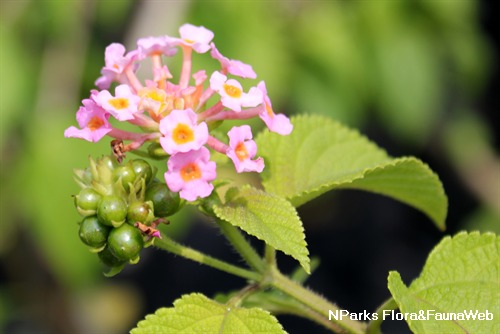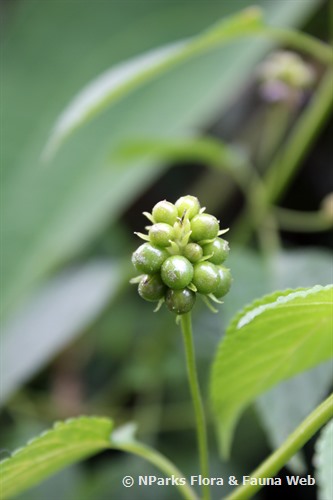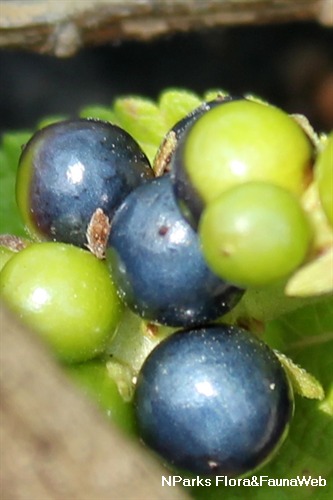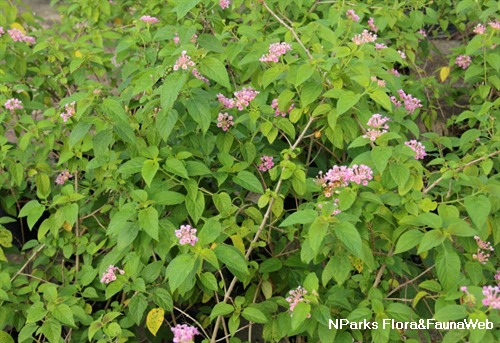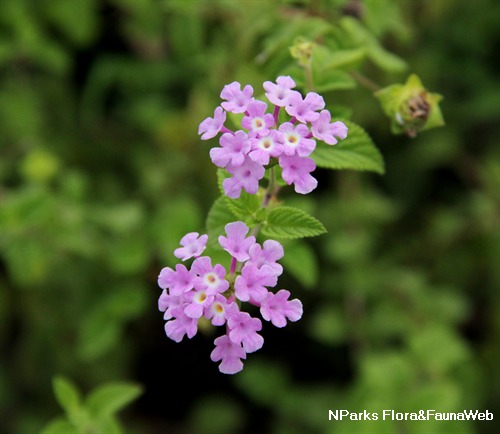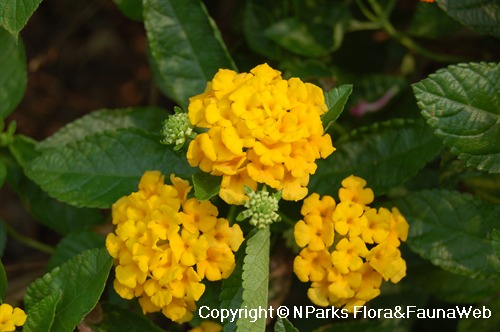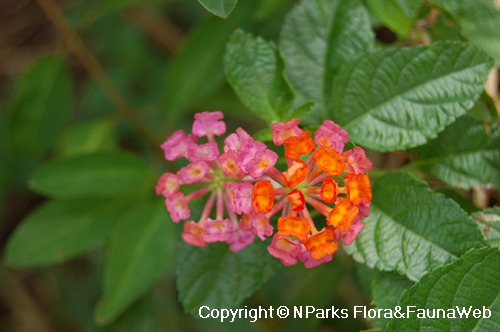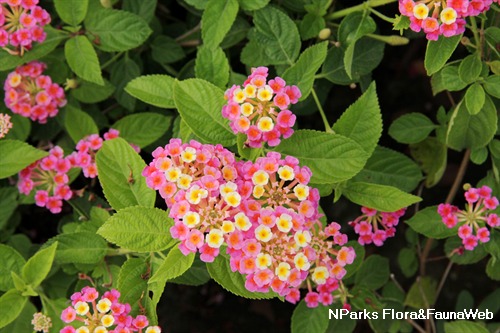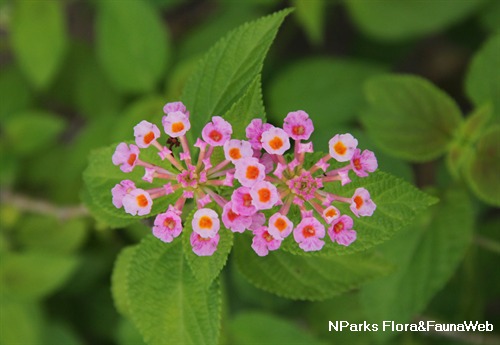
Back
Lantana camara L.
| Family Name: | Verbenaceae |
| Synonyms: | Caryopteris hispida, Lantana aculeata |
| Common Name: | Lantana, Common Lantana, Shrub Verbena, Spanish Flag, Tick Berry, Bunga Tahi Ayam, Bunga Pagar, 五色梅, 马缨丹 |
Name
Classifications and Characteristics
| Plant Division | Angiosperms (Flowering Seed Plants) (Dicotyledon) |
|---|---|
| Plant Growth Form | Shrub |
| Lifespan (in Singapore) | Perennial |
| Mode of Nutrition | Autotrophic |
Biogeography
| Native Distribution | Mexico, Caribbean, Venezuela, Colombia |
|---|---|
| Native Habitat | Terrestrial |
| Preferred Climate Zone | Tropical |
| Local Conservation Status | Non-native (Spontaneous (Naturalised)) |
Description and Ethnobotany
| Growth Form | Multi-branched shrub, up to 1.2 m tall. |
|---|---|
| Foliage | Leaves rough-hairy with coarsely-serrated margin, emit a pungent scent when crushed or rubbed -- hence the Malay name 'Bunga Tahi Ayam' (Chicken Dung Flower). |
| Stems | Stems square or 3-angled, covered with bristly hairs when young, often armed with scattered hooked prickles when mature. |
| Flowers | Flowers multi-coloured, changing colour over time and with pollination, held in showy clusters, attract butterflies. |
| Fruit | Fruits 2-seeded globose berries, ripen from green to deep blue or purple-black, eaten by birds which disperse the seeds |
| Ethnobotanical Uses | Medicinal: In Chinese medicine, a decoction of the plant is used as a bath for scabies and leprosy. The leaves are used in Indochina as a stimulant, to expel intestinal worms and to increase menstrual flow. They are applied to ulcers, cuts and swellings in Indonesia, Malaysia and the Philippines. |
Landscaping Features
| Desirable Plant Features | Fragrant (Flowers), Ornamental Flowers |
|---|---|
| Landscape Uses | General, Flowerbed / Border, Coastal, Container Planting, Parks & Gardens |
| Usage Hazard - Cons | Toxic Upon Ingestion, Invasive / Potentially Invasive |
| Usage Hazard - Cons Remarks | Handling of leaves may cause skin irritation. Unripe berries and leaves known to be toxic if consumed. May become invasive in certain areas. Allelopathy is reported to play a crucial role in the invasiveness of L. camara. Documented allelopathic effects include supression of germination and growth of other plant species through release of allelochemicals in the soil (rhizosphere) or in the air (volatile compounds) from living plants. A common weed in Malaysia's plantations, where it grows as dense monospecies, understorey vegetation. |
Fauna, Pollination and Dispersal
| Fauna Pollination Dispersal Associated Fauna | Bird-Attracting, Butterfly-Attracting, Butterfly Host Plant (Leaves), Bee-Attracting |
|---|---|
| Pollination Method(s) | Biotic (Fauna) (Insects (Butterfly, Moth)) |
| Seed or Spore Dispersal | Biotic (Fauna) |
Plant Care and Propagation
| Light Preference | Semi-Shade, Full Sun |
|---|---|
| Water Preference | Moderate Water, Little Water |
| Plant Growth Rate | Fast |
| Rootzone Tolerance | Well-Drained Soils, Poor Infertile Soils, Drought Tolerant |
| Propagation Method | Seed |
Foliar
| Foliage Retention | Evergreen |
|---|---|
| Mature Foliage Colour(s) | Green |
| Foliar Attachment to Stem | Petiolate |
Floral (Angiosperm)
| Flower & Plant Sexuality | Bisexual Flowers |
| Inflorescence Size Remarks | Flowers colours darken after pollination. |
|---|
Fruit, Seed and Spore
| Fruit Classification | Simple Fruit |
|---|---|
| Fruit Type | Fleshy Fruit , Berry |
References
| References | Kato-Noguchi H, Kurniadie D. Allelopathy ofLantana camaraas an Invasive Plant.Plants (Basel). 2021;10(5):1028. Published 2021 May 20. doi:10.3390/plants10051028 |
|---|
Image Repository
Others
| Master ID | 884 |
|---|---|
| Species ID | 2178 |
| Flora Disclaimer | The information in this website has been compiled from reliable sources, such as reference works on medicinal plants. It is not a substitute for medical advice or treatment and NParks does not purport to provide any medical advice. Readers should always consult his/her physician before using or consuming a plant for medicinal purposes. |

